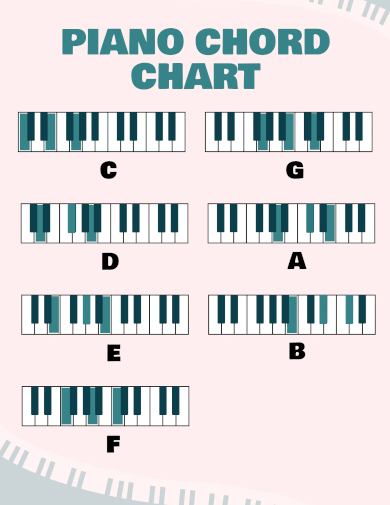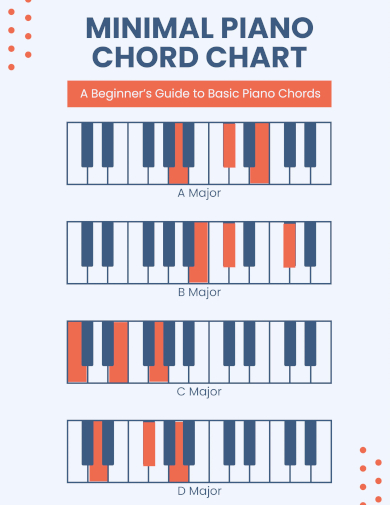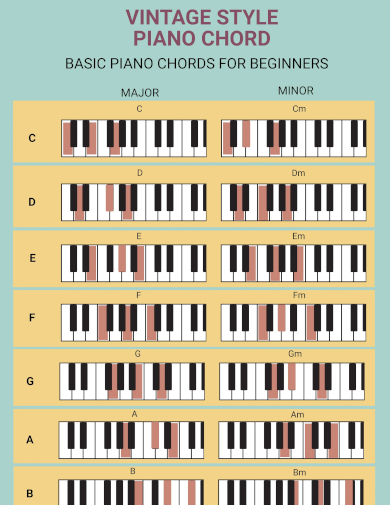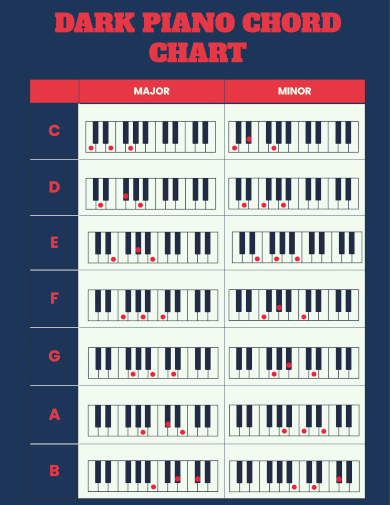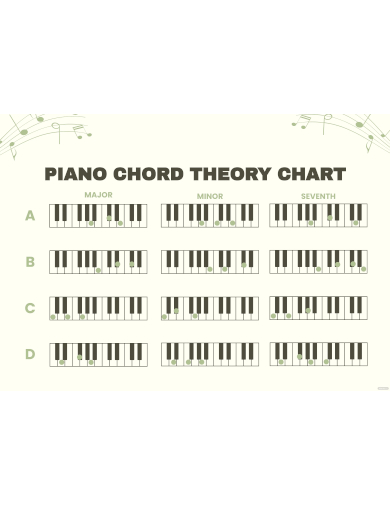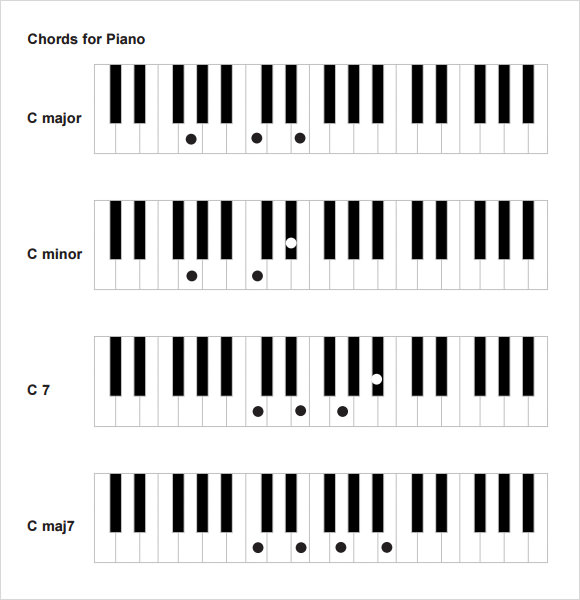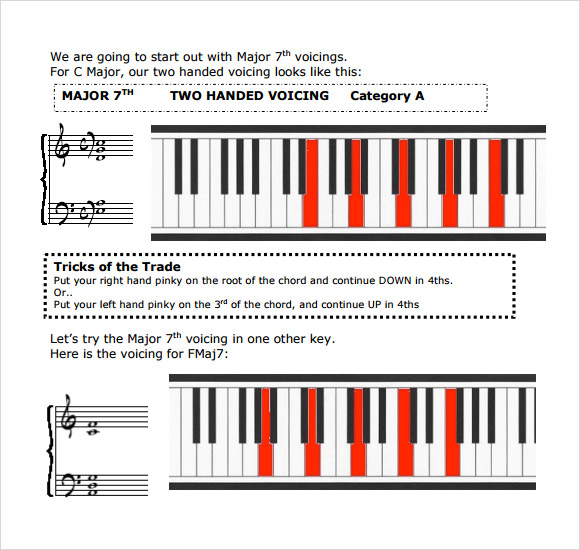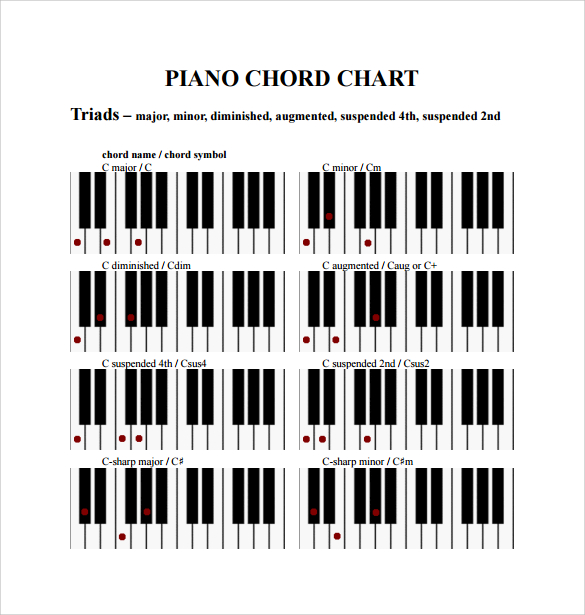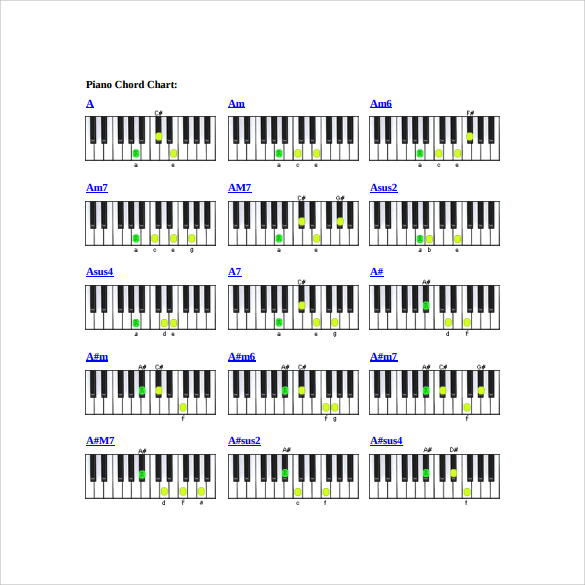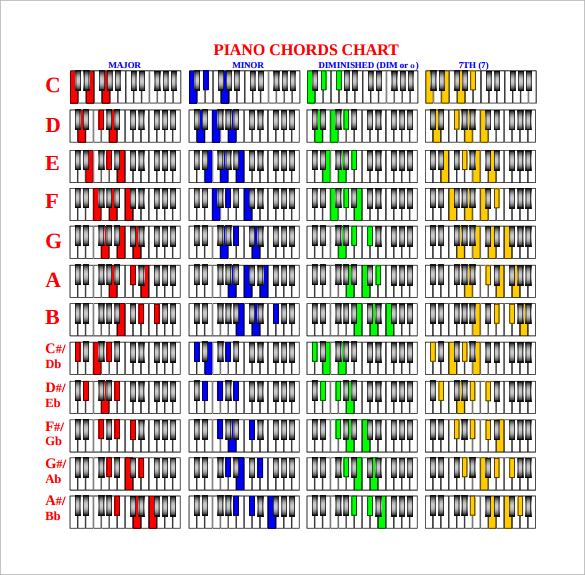The Piano Chord Chart is much similar to the Piano Notes Chart or any other musical instrument chart and it acts as a readymade piano guide. You can learn the minor and the major triads at first according to the keyboard image. They are free chart templates for download in both word and excel format. So, you can download in your convenient format and practice. You can also take print outs and practice the cords and scales as they are the basic of the piano. It will act as a first hand guide and is also free. So, you can obviously try out the nodes and cords designed by the experts.
Piano Chord Chart Template
Blank Piano Chord Chart Template
Free Minimal Piano Chord Chart Template
How to Read Piano Chords For Beginners?
Reading piano chords as a beginner can be broken down into several simple steps. Here’s a guide to get you started:
1. Understand the Basics of Chords
- Chords are a combination of three or more notes played together.
- The most basic chords are major and minor chords.
2. Learn the Notes on the Piano
- Familiarize yourself with the names and locations of notes on the keyboard.
- The piano is composed of repeating groups of seven notes: A, B, C, D, E, F, G.
- White keys are named A-G, while black keys are the sharps (#) and flats (b) of these notes.
3. Major and Minor Chords
- Major Chord: Made up of the root note, a major third, and a perfect fifth.
- Example: C Major (C, E, G)
- Minor Chord: Made up of the root note, a minor third, and a perfect fifth.
- Example: C Minor (C, E?, G)
4. Chord Symbols
- Chords are often written in shorthand using letters and symbols.
- Major chords: Just the letter (C, F, G)
- Minor chords: The letter followed by an “m” (Cm, Fm, Gm)
- Sharp chords: Indicated by a “#” (C#, F#, G#)
- Flat chords: Indicated by a “b” (Cb, Fb, Gb)
5. Practice Basic Chords
- Start by practicing simple major and minor chords.
- Place your thumb on the root note, your middle finger on the third, and your pinky on the fifth.
- Practice transitioning between different chords to build muscle memory.
6. Chord Inversions
- Root Position: The root note is the lowest note.
- First Inversion: The third is the lowest note.
- Second Inversion: The fifth is the lowest note.
- Example: C Major in root position (C, E, G), first inversion (E, G, C), second inversion (G, C, E).
7. Use Chord Charts and Diagrams
- Chord charts show the notes for each chord and can be a handy reference.
- Diagrams can illustrate finger placement on the keyboard.
8. Play Along with Songs
- Find simple songs or chord progressions to practice.
- Use sheet music or chord charts to play along. You can also see more on Capo Chart.
Vintage Style Piano Chord Chart Template
Piano Intermediate Chord Chart Template
Free Dark Piano Chord Chart Template
Piano Chord Theory Chart Template
What are the 4 Chords used in Most Songs Piano?
Many popular songs use a common progression of four chords. Here are the four chords often used, along with their notes in the key of C major:
The 4 Chords
- C Major (I)
- Notes: C, E, G
- G Major (V)
- Notes: G, B, D
- A Minor (vi)
- Notes: A, C, E
- F Major (IV)
- Notes: F, A, C
Playing the 4 Chords Progression
In the key of C major, you can play these chords in sequence to create a progression that is commonly used in many songs:
- Start with C Major (C, E, G)
- Then play G Major (G, B, D)
- Next, play A Minor (A, C, E)
- Finally, play F Major (F, A, C)
Example in a Simple Sequence
- C Major
- Left hand: C (octave if possible)
- Right hand: C, E, G
- G Major
- Left hand: G (octave if possible)
- Right hand: G, B, D
- A Minor
- Left hand: A (octave if possible)
- Right hand: A, C, E
- F Major
- Left hand: F (octave if possible)
- Right hand: F, A, C
By practicing these chords and transitioning smoothly between them, you’ll be able to play the basic progression that forms the backbone of many popular songs. You can also see more on Guitar Chords Chart.
Piano Chord Chart PDF
Printable Piano Chord Chart Template
Sample Piano Chord Chart Template
How Do I Learn Piano by Myself?
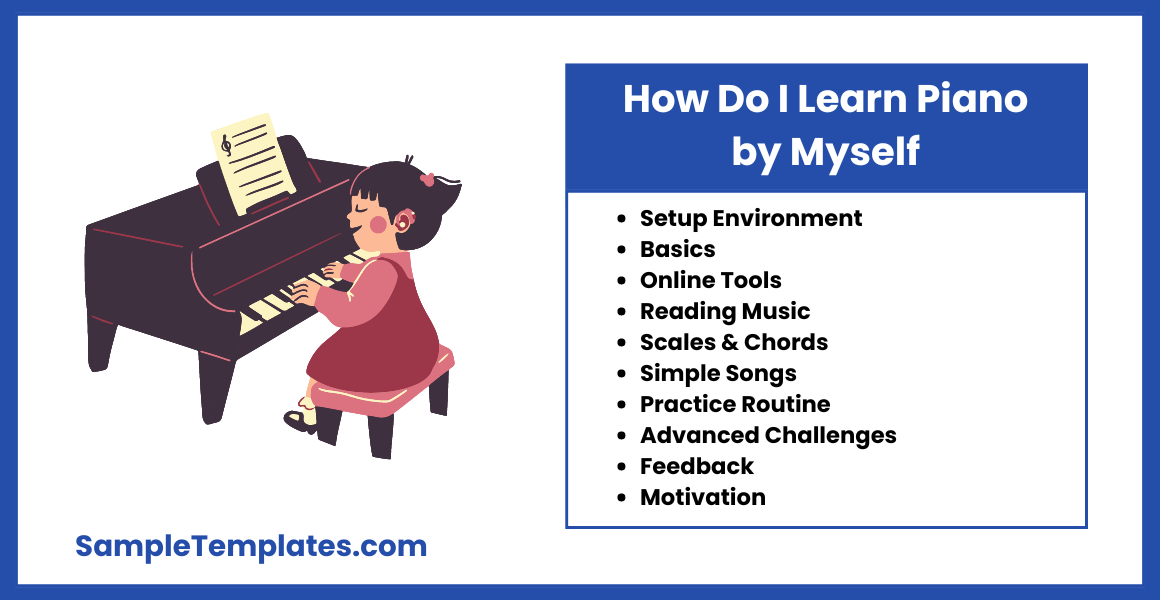
Learning piano by yourself can be a rewarding experience. Here are some steps to help you get started and stay motivated:
1. Set Up Your Learning Environment
- Instrument: Ensure you have a piano or keyboard. If you use a keyboard, make sure it has weighted keys to simulate the feel of an acoustic piano.
- Location: Find a quiet, comfortable place to practice.
2. Learn the Basics
- Identify the Keys: Understand the layout of the piano. Learn the names of the keys (A, B, C, D, E, F, G) and the pattern of the black and white keys.
- Finger Positioning: Learn proper hand and finger placement. Number your fingers (thumb is 1, index is 2, etc.).
- Posture: Sit with a straight back, relaxed shoulders, and your feet flat on the floor.
3. Use Online Resources and Apps
- Tutorials: Watch YouTube videos and tutorials for beginners.
- Apps: Use piano learning apps like Simply Piano, Flowkey, or Piano Marvel.
- Websites: Explore websites with free resources like Pianote, Hoffman Academy, or Musictheory.net.
4. Learn to Read Music
- Notes: Learn to read sheet music, starting with the treble and bass clefs.
- Rhythms: Understand basic note values (whole, half, quarter, eighth notes) and rests.
- Practice: Use beginner sheet music to practice reading notes and rhythms.
5. Practice Scales and Chords
- Scales: Start with the C major scale. Practice playing it slowly with both hands. You can also see more on Music Chart.
- Chords: Learn basic chords (major and minor) and practice transitioning between them.
6. Play Simple Songs
- Start Simple: Begin with easy songs like “Twinkle, Twinkle, Little Star” or “Mary Had a Little Lamb.”
- Sheet Music: Use beginner sheet music books or online resources.
- Play by Ear: Try to play simple melodies by ear to develop your listening skills.
7. Develop a Practice Routine
- Consistency: Practice regularly, even if it’s just 15-30 minutes a day.
- Warm-Up: Start with scales and finger exercises to warm up.
- Break it Down: Focus on small sections of a piece before putting it all together.
- Record Yourself: Recording can help you track your progress and identify areas for improvement.
8. Challenge Yourself Gradually
- New Pieces: Gradually introduce more complex pieces as you improve.
- Techniques: Learn new techniques like arpeggios, dynamics, and pedal usage.
- Theory: Study basic music theory to understand what you’re playing.
9. Seek Feedback
- Online Communities: Join piano forums or social media groups for advice and support.
- Friends/Family: Play for friends or family to get feedback and build confidence.
10. Stay Motivated
- Set Goals: Have short-term and long-term goals to keep you focused.
- Enjoy the Process: Choose pieces you enjoy to keep your practice sessions fun.
- Celebrate Progress: Acknowledge your achievements, no matter how small.
By following these steps and staying committed, you can successfully learn to play the piano on your own. You can also see more on Music Sheet.
Printable Piano Chord Chart Template
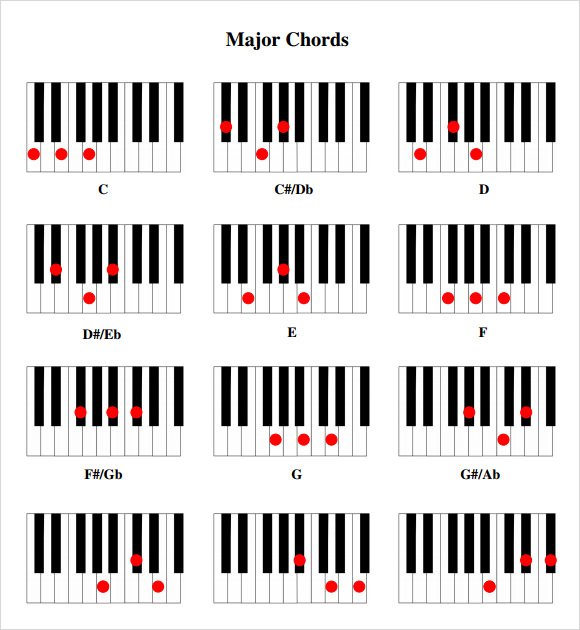
Piano Jazz Chord Chart Template
Piano Chord Chart Example
Basic Piano Chord Chart Template
Tips For Creating Piano Chord Chart
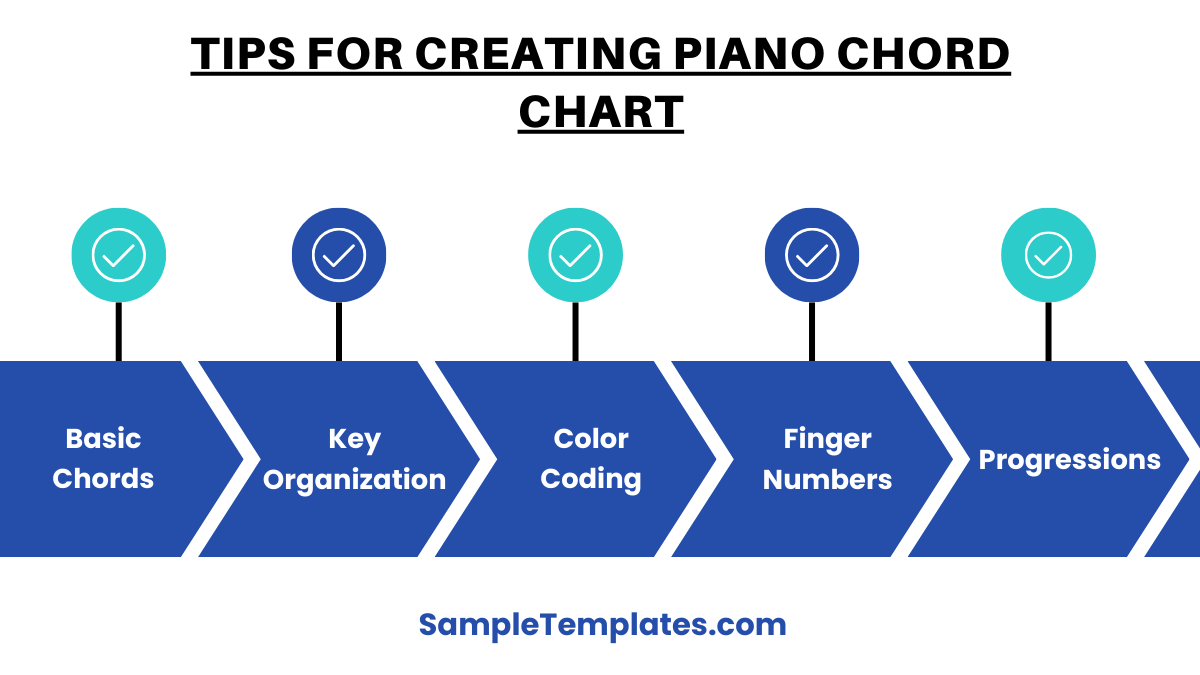
- Include All Basic Chords:
- Ensure your chart has all the major, minor, diminished, and augmented chords for each key.
- Organize by Key:
- Arrange chords alphabetically by the root note (e.g., C, C#, D, D#) to make it easy to find specific chords.
- Color-Coding:
- Use different colors for different chord types (e.g., major, minor, diminished, augmented) to visually distinguish them.
- Show Inversions:
- Include diagrams or notes on common chord inversions to show different ways to play the same chord.
- Include Finger Numbers:
- Add suggested fingerings for each chord to help beginners place their fingers correctly.
- Visual Diagrams:
- Incorporate keyboard diagrams showing which keys to press for each chord.
- Highlight Common Progressions:
- Provide examples of common chord progressions (e.g., I-IV-V, ii-V-I) to help understand how chords are used in songs. You can also see more on Musical Note.
Piano Chord Chart Format
What are the chords on a piano?
Piano chords are combinations of three or more notes played together. Common types include major, minor, diminished, and augmented chords. Major chords have a happy sound, while minor chords sound sad. Diminished and augmented chords add tension. you can also see more on Staff Paper.
How to remember chords in piano?
To remember piano chords, practice regularly, break them down into patterns, and associate them with songs you know. Use mnemonics and visual aids, and play by ear to reinforce muscle memory. Repetition and familiarity are key.
What piano chords should I learn first?
Start with major and minor chords: C, G, D, A, and E major, plus A, E, and D minor. These foundational chords are widely used in many songs and will help you play a variety of music.
What are the 4 golden chords?
The four golden chords are C major, G major, A minor, and F major. These chords are the backbone of many popular songs and are often used in chord progressions for their pleasing harmony.
How do you read piano notes for dummies?
To read piano notes, understand the staff, which has five lines and four spaces. Each line and space represents a different note. Middle C is a central reference point. Learn note names, clefs, and practice recognizing patterns for fluency. You can also see more on Music Paper.
A piano chord chart is a valuable tool for beginners and advanced players alike, providing a visual reference of key placements for major, minor, and other complex chords, simplifying learning and enhancing musical creativity and expression.
If you have any DMCA issues on this post, please contact us!
Related Posts
8 Pitching Chart Templates
7 RACI Chart Templates for Free Download
7+ Sin Cos Tan Chart Templates
7 Military Alphabet Chart Templates
6+ Non Profit Organizational Charts
10+ Sample Human Resources Organizational Charts
16+ Amino Acid Chart Templates
15+ Sample Tap Drill Charts
13+ Sample Fire Department Organizational Charts
11+ Sample Hair Color Chart Templates
10+ Sample Chore Chart Templates
9+ Morse Code Alphabet Chart Templates
9 Sample IPA Chart Templates
9+ Sample Food Coloring Chart Templates
9+ Sample Urine Color Charts

